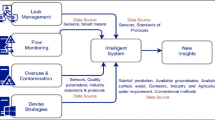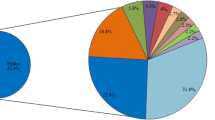Abstract
Planning of water resources systems is often associated with many uncertain parameters and their interrelationships are complicated. Stochastic planning of water resources systems is vital under changing climate and increasing water scarcity. This study proposes an interval-parameter two-stage optimization model (ITOM) for water resources planning in an agricultural system under uncertainty. Compared with other optimization techniques, the proposed modeling approach offers two advantages: first, it provides a linkage to pre-defined water policies, and; second, it reflects uncertainties expressed as probability distributions and discrete intervals. The ITOM is applied to a case study of irrigation planning. Reasonable solutions are obtained, and a variety of decision alternatives are generated under different combinations of water shortages. It provides desired water-allocation patterns with respect to maximum system benefits and highest feasibility. Moreover, the modeling results indicate that an optimistic water policy corresponding to higher agricultural income may be subject to a higher risk of system-failure penalties; while, a too conservative policy may lead to wastage of irrigation supplies.


Similar content being viewed by others
References
Abrishamchi A, Marino MA, Afshar A (1991) Reservoir planning for irrigation district. J Water Resour Pl Manage 117:74–85
Bender MJ, Simonovic SP (2000) A fuzzy compromise approach to water resource systems planning under uncertainty. Fuzzy Set Syst 115:35–44
Carey JM, and Zilberman D (2002) A model of investment under uncertainty: modern irrigation technology and emerging markets in water. Am J Agr Econ 84:171–183
CDDC (Center for Digital Discourse and Culture) (2004) Choices and challenges project: sharing the earth’s water supply, Virginia Tech, Blacksburg, Virginia 24061, http://www.cddc.vt.edu
Eiger G, Shamir U (1991) Optimal operation of reservoirs by stochastic programming. Eng Optimiz 17: 293–312
Escudero LF (2000) WARSYP: a robust modeling approach for water resources system planning under uncertainty. Ann Oper Res 95:313–339
Guo HC, Liu L, Huang GH, Zao R, Yin YY (2001) A system dynamics approach for regional environmental planning and management: a study for the Lake Erhai Basin. J Environ Manage 61:93–112
Gupta AD, Paudyal GN (1990) Nonlinear chance constrained model for irrigation planning. Agr Water Manage 18:87–100
Huang GH (1996) IPWM: an interval parameter water quality management model. Eng Optimiz 26:79–103
Huang GH (1998) A hybrid inexact-stochastic water management model. Eur J Oper Res 107:137–158
Huang GH, Loucks DP (2000) An inexact two-stage stochastic programming model for water resources management under uncertainty. Civ Eng Environ Syst 17:95–118.
Huang G, Baetz BW, Patry GG (1994) Grey dynamic programming for solid waste management planning under uncertainty. J Urban Plan D 120:132–156
Jairaj PG, Vedula S (2000) Multireservoir system optimization using fuzzy mathematical programming. Water Resour Manage 14: 457–472
Loucks DP, Stedinger JR, Haith DA (1981) Water resource systems planning and analysis. Prentice-Hall, Englewood Cliffs
Mobasheri F, Harboe RC (1970) A two-stage optimization model for design of a multipurpose reservoir. Water Resour Res 6: 22–31
Mylopoulos YA, Theodosiou N, Mylopoulos NA (1999) A stochastic optimization approach in the design of an aquifer remediation under hydrogeologic uncertainty. Water Resour Manage 13: 335–351
Paudyal GN, Gupta AD (1990) Irrigation management by multilevel optimization. J Irrig Drain Eng 116: 273–291
Rohde FG, Naparaxawong K (1981) Modified standard operation rules for reservoirs. J Hydrol 51: 169–177
Russell SO, Campbell PF (1997) Reservoir operating rules with fuzzy programming. J Water Resour Pl Manage 123:312
Sahoo GB, Loof R, Abernethy CL, Kazama S (2001) Reservoir release policy for large irrigation system. J Irrig Drain Eng 127: 302–310
Seifi A, Hipel KW (2001) Interior-point method for reservoir operation with stochastic inflows. J Water Resour Pl Manage 127: 48–57
Sritharan S, Clyma W, Richardson E (1988) On-farm application system design and project-scale water management. J Irrig Drain Eng 11: 622–643
Teegavarapu RSV, Simonovic SP (1999) Modeling uncertainty in reservoir loss functions using fuzzy sets. Water Resour Res 35: 2815–2824
Van Duc L, Gupta AD (2000) Water resources planning and management for lower Dong Nai River Basin, Vietnam: application of an integrated water management model. Int J Water Resour Dev 16: 589–613
Wagner JM, Shami U, Marks DH (1994) Containing groundwater contamination: planning models using stochastic programming with recourse. Eur J Oper Res 77: 1–26
Lou B, Maqsood I, Yin YY, Huang GH, Cohen SJ (2003) Adaptation to climate change through water trading under uncertainty—An inexact two—stage nonlinear programming approch. J Env Informatics 2:58--68
Li JB (2003) Integration of stochastic programming and factional design for optimal reservoir operation. J Env Informatics 1:11--30
Hoppe H, Weilandt M, Orth H (2004) A combined water management approach based on river water quality standards. J Env Informatics 3:67--76
Wang LZ, Fang L, Hipel KW (2003) Water resources allocation: a cooperative game theoratic approch. J Env Informatics 2:11--22
Author information
Authors and Affiliations
Corresponding author
Appendix
Appendix
List of symbols
The following symbols are used in this paper:
- f ± :
-
Net system benefit ($/m3)
- f ±opt :
-
Optimized net system benefit ($/m3)
- B ± i :
-
Net benefit to farm i per m3 of water allocated ($)
- W ± i :
-
Water policy in terms of fixed allocation amount of water that is promised to farm i (m3)
- W ±imax :
-
Maximum allowable allocation amount for farm i (m3)
- C ± i :
-
Loss to farm i per m3 of water not delivered, C i > B i ($)
- S ± ij :
-
Decision variable representing shortage of water, which is the amount by which W i is not met when the seasonal flow is q j (m3)
- S ±ij opt :
-
Optimized solution of S ± ij decision variable
- q ± j :
-
Reservoir flow quantity with probability p j of occurrence under flow level j (m3)
- p j :
-
Probability of occurrence of flow level j (%)
- i :
-
Cropping farm index; i=1, 2, 3 where i=1 represents alfalfa farm, 2 represents wheat farm, and 3 represents potato farm
- j :
-
Flow level index, j = 1, 2, ..., 5 where j = 1 for very low flows, 2 for low flows, 3 for medium flows, 4 for high flows, and 5 for very high flows
- m :
-
Total number of farms
- n :
-
Total number of flow levels
- z i :
-
Binary decision variable
Rights and permissions
About this article
Cite this article
Maqsood, I., Huang, G., Huang, Y. et al. ITOM: an interval-parameter two-stage optimization model for stochastic planning of water resources systems. Stoch Environ Res Ris Assess 19, 125–133 (2005). https://doi.org/10.1007/s00477-004-0220-6
Published:
Issue Date:
DOI: https://doi.org/10.1007/s00477-004-0220-6




